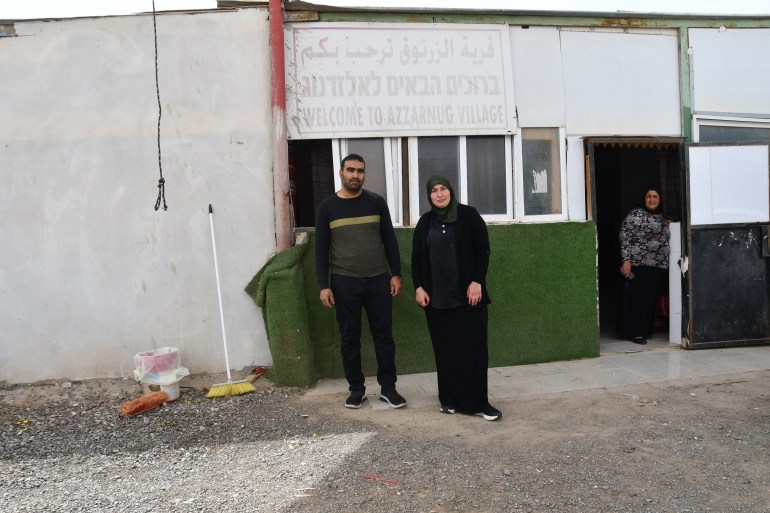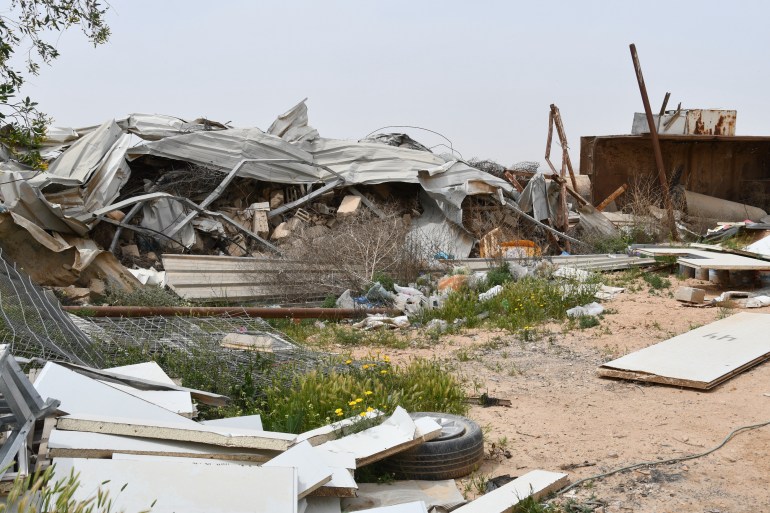Naqab, Israel – In 1992, Mohamed Abu Qwaider saw his mother’s house bulldozed by the Israeli army in the unrecognized Bedouin village of az-Zarnug in the Naqab desert.
The then 10-year-old helped his family rebuild the house using stone and concrete, sturdier than the previous metal hut. A few days after completing their new home, the family received another demolition order stating that the building had been illegally constructed and that they should watch it be razed to the ground.
“I was too young, so I didn’t know the rules,” said Abu Qwaider, now 41. “I only knew that we had the right – everyone has the right to upgrade their home and live peacefully,” he told Al Jazeera.
More than 30 years later, the constant cycle of demolition and reconstruction has not stopped, but is accelerating as the Israeli government ramps up its campaign against Palestinian Bedouin construction.
Recent data from the Negev Coexistence Forum for Civil Equality (NCF), an Arab-Jewish NGO advocating for Bedouins in the Naqab (or Negev) desert, shows that about 15,000 buildings have been razed in the past six years in the Bedouin areas of the Naqab. .
Demolition of houses is not unusual for Palestinians, but often the focus is on the occupied territory. Palestinian Bedouins in the Naqab did not leave their hometowns after the State of Israel was established in 1948 and subsequently received Israeli citizenship, unlike the Palestinians living in the occupied West Bank and occupied East Jerusalem.
Israeli authorities have repeatedly vandalized both recognized and unrecognized villages in the southern desert region, where most of Israel’s 200,000 Bedouin live. But only 11 of the 35 Bedouin villages have been recognized by Israel, meaning most homes are considered “illegal.”

Israeli authorities regulate construction activities in the desert, but they have failed to implement urban plans in many villages due to land tenure disputes or due to the backlog in approving building permit applications. Palestinian Bedouin say it is almost impossible to get permits to build legally.
In this respect, there is virtually no difference between recognized and non-recognized villages, as both residents are often unable to obtain building permits and basic infrastructure of water, electricity, sewerage and roads is lacking.
While the highest number of vandalisms – 192 in 2022 – occurred in the unrecognized village of al-Furah, the recognized Bedouin town of Rahat – the largest Bedouin town in Naqab – had the second highest number of vandalisms at 176.
This year, the number of demolitions has already risen sharply, with the Israel Lands Authority (ILA) distributing 450 demolition notices to Naqab residents in February.
Huda Abu Obaid, a coordinator at NCF, the Arab-Jewish NGO, said they expect demolitions to rise this year, attributing the increase to technological developments and the new hard-line government in office.
“It’s political. If this was a left-wing government, the situation would be different,” said Abu Obaid, noting how the previous government recognized three Bedouin villages in 2021.
The high number of demolition reports in February is due to an operation called Southern Hawk, which uses a new artificial intelligence-based system developed by the Israeli arms company Rafael to scan 1 million dunams (about 250,000 acres) of land to find new Bedouins. detect structures.
While focusing on new construction, NCF CEO Haia Noach explained that when new buildings are not found, ILA inspectors classify old buildings that have been repaired or renovated as new buildings. In one case, seven houses from the 1980s and early 2000s were demolished in February.
“There are houses around mine that were built 50 years ago,” said Abu Qwaider. “In the past 10 to 15 years, it’s been extremely impossible to build or add a new structure to your building.”
Like his mother, Abu Qwaider’s three brothers were also scrapped. After one of his brothers lost his house in 2021, Abu Qwaider added a room to his house for his brother to sleep. Immediately after construction, the family received a demolition order and the room was destroyed.
The ILA did not respond to questions from Al Jazeera about Southern Hawk and its connection to the increase in demolitions.
Building Jewish houses on top of Bedouin ruins
As part of the coalition deal with the Religious Zionist Party, Prime Minister Benjamin Netanyahu’s far-right government plans to allocate 1.6 billion shekels (about $443 million) over the next two years for accelerated Jewish settlement in the Naqab “to demographic balance” there.
Previous governments have already set these wheels in motion. In 2022, the government of then Prime Minister Naftali Bennett approved the establishment of four Jewish towns in the Naqab. In 2015, the Supreme Court led by Netanyahu ruled on the demolition of the unrecognized village of Umm al-Hiran to build the Jewish settlement of Hiran on the rubble.
Today, the village’s ethnic cleansing is evident as piles of ruined Bedouin houses lie in the shadow of towering bulldozers.

While the pace of demolition has escalated recently, Abu Qwaider said the agenda of left-wing and right-wing governments is indistinguishable. The speed and execution of demolition may differ, but the mindset is the same.
“There is no difference between the left and right governments and their policies of hatred towards the Arab Palestinians in the Naqab,” said Abu Qwaider.
Standing among the ruins of his cousin’s house, which was demolished three times last year, Abu Qwaider said hundreds of houses in his village are slated to be demolished. His cousin self-demolished his house for the third time to avoid paying 50,000 shekels (nearly $13,750) in government demolition fees. Yet he was still fined 30,000 shekels (about $8,250) for illegal construction. Now he, his wife and four children live in one room in the parental home.
Amidst the rubble, the marble floor of his cousin’s house remains intact, indicating he has plans to rebuild.
“Like so many people, rebuilding a demolished building feels like an act of defiance,” said Abu Qwaider, describing how his family gradually rebuilt his mother’s house after its demolition.
“That’s what the community does,” Abu Qwaider said. “Once their house is torn down, people get together, they rebuild the demolished building, and then people live again until you really run out of options.”